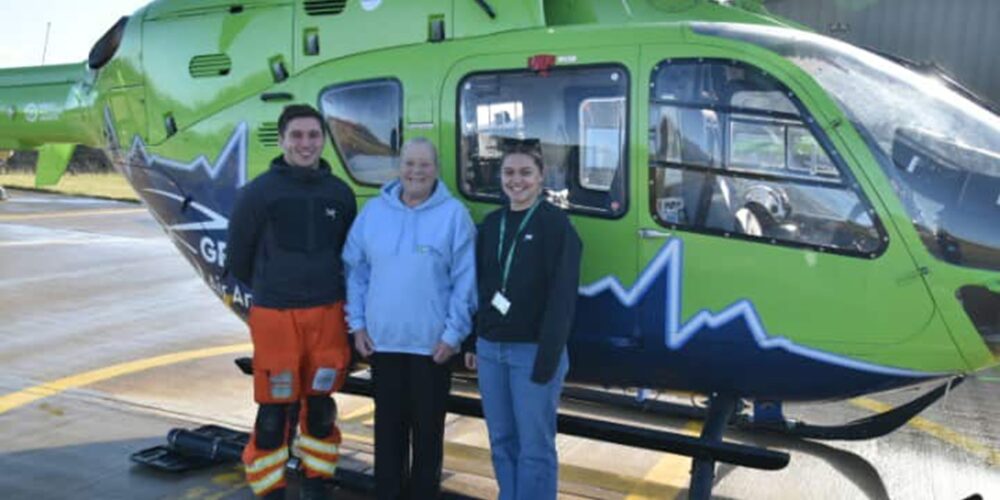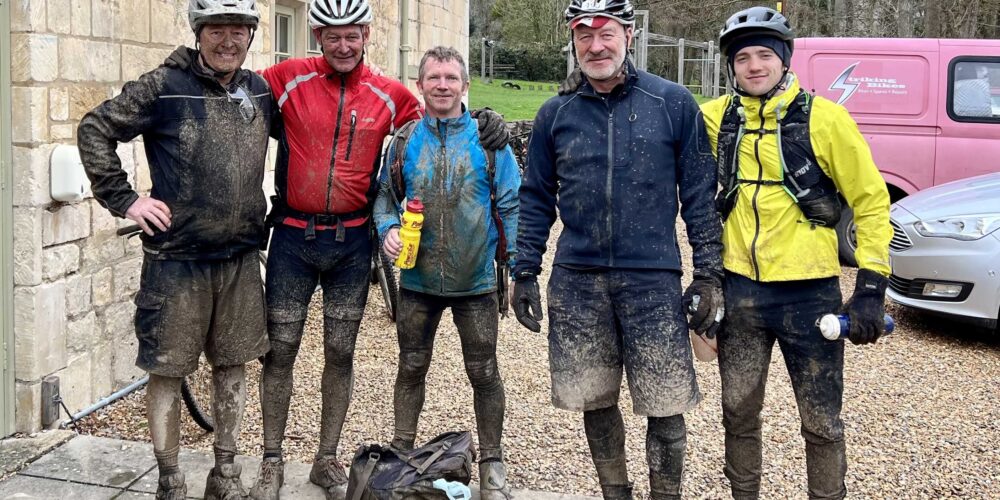
Meet our Pilots on #WorldPilotDay
April 26, 2024
“I have my son thanks to GWAAC” – Rach and Ollie’s story
June 5, 2024Simon lay on his hospital bed unable to speak or move. A machine worked away, breathing for him and he was connected to multiple tubes. Concerned faces stared down at him. “Simon,” they said, “This is as good as it’s going to get. You need to accept this.”
“No,” he thought. “No, I don’t.”
Nearly five years later the man who was told he wouldn’t walk, talk, eat, or breathe for himself again, trekked across Iceland and stuck a proverbial two-fingers up to the blow that life had dealt him.
People ask him now, why do you do so much, Simon? Why do you push yourself so hard? Simon says, “I’m under no illusion… without the help of that team from Great Western Air Ambulance Charity, I would not be here today. They gave me a second chance and I owe it to them to make the most of it.”
It was a miserable October evening…
Simon doesn’t remember the accident or the two days preceding it. He says, “I was living my best life, then one evening we went out to get some groceries and I woke up three and a half months later.”
Tragically Simon’s partner of twenty-two years was killed from the impact of the road traffic collision. It’s something he will never get over, and something he must learn to cope with as part of his new life; a life that was set back to zero on the night of 17 October 2019.
It was only a short car journey to the supermarket in Cirencester, down a road they’d driven thousands of times before. That night it was dark and it was raining. They lost control on a bend, the tyre hitting something that caused it to deflate and spinning them sideways onto the wrong side of the road. They collided with a car travelling at speed in the other direction.
The Police and the Fire Service were first on the scene, followed by three ambulance crews and two air ambulances; one of which was Great Western Air Ambulance Charity (GWAAC). Simon needed the specialist skills of its Critical Care Team.
“Simon was one of the most broken people I’ve ever seen”
Specialist Paramedic in Critical Care (SPCC) Pete, was one of the three GWAAC crew that helped Simon that night. Reflecting on the incident some years later and having met Simon several times since, Pete says, “Simon was one of the most broken people I’ve ever seen that has survived. I don’t know how much more broken you can get.”
Simon jokes that it’s easier to say what he didn’t hurt: “From top to bottom… I shattered the top three vertebrae of my spine, which meant my head was being held on by muscle and skin alone. I broke all of the ribs on my left side. I broke my sternum. I broke the top four ribs on my right side. My lungs were punctured. I had a two-and-a-half-inch hole in my aorta. My heart was severely damaged. My lower organs and intestines were forced into my chest cavity which tore my diaphragm. I punctured all of my lower organs. I shattered my pelvis and the bottom vertebrae that attach to my pelvis. I broke my hips and my wrist. I was very lucky that I didn’t break my legs.”
Critical Care Doctor Lou and Specialist Paramedics Pete and Jack rushed to help Simon in one of GWAAC’s fully-equipped critical care cars from the charity’s airbase in Almondsbury, South Gloucestershire. As they walked towards the scene, they saw carnage. In the light of a spotlight, two cars were almost unrecognisable due to the damage. It was an early indication of just how critically ill Simon was.
Dr Lou went immediately to assess Simon who was already on a stretcher in the back of an ambulance and SPCC’s Pete and Jack set up the kit needed to do an emergency anaesthetic and to give blood.
Saving Simon
The GWAAC Team’s priority was to get Simon to the point of survivability and stable enough to make the trip to hospital. Pete said, “We gave him pretty much every treatment that we had.”
The team anaesthetised Simon and gave him several blood transfusions. They also did a thoracostomy — a surgical procedure to go in through the chest wall to relieve fluid and pressure building up on Simon’s lungs. Simon marvels at this. He says, “That procedure, and everything else they did for me, is usually done in a hospital. They did it for me on the side of the road, in the dark, in the wet. And I didn’t make it easy for them. Even on the way to hospital, I kept them busy the whole time!”
It was a 45-minute journey by ambulance to the nearest Major Trauma Centre — Southmead Hospital in Bristol. The GWAAC Team actively decided to take Simon to Southmead, bypassing closer hospitals, because Simon needed the best possible continuation of care for his needs. The Team went with him in the ambulance, managing the drugs and blood that he needed, making sure he got there alive and stable.
Still here because of GWAAC
The Team’s interventions — the anaesthetic, the thoracostomy, and the blood transfusions — made the difference between life and death for Simon. Without them, Simon would likely have died on the way to hospital.
But it wasn’t just about the equipment and the procedures they performed; it was about the decision-making at the scene. SPCC Pete says, “We bring interventions that have traditionally only been done in the emergency department and we bring them out to the patient and that includes the experience and the decision-making. And the real skill of critical care is knowing when not to do something.”
One of the decisions the Team made that night was the order in which to do things for Simon. His blood pressure was extremely low when they reached him, and it was still dropping. The Team decided to administer blood at the same time as the anaesthetic to speed up the time on scene. SPCC Jack said, “Simon needed all of these interventions within minutes of us being at his side. We had to work very quickly to get a handle on the situation to stop him from deteriorating.”
The priority for the GWAAC Team was to get Simon to Southmead Hospital where his complex medical needs could continue to be managed.
GWAAC’s Critical Care Team made a difference that night, but they were also part of a much wider team that brought Simon out the other side. And once on the road to recovery, it was Simon’s steel-like determination that got him to where he is today.
Still climbing mountains
Simon fell in love with mountains from an early age and got into rock climbing and exploring; he was fit and active and relished a challenge. The accident changed everything for Simon, but not his spirit.
“Lots of people were telling me that I would live the rest of my life on a breathing machine being fed through a straw up my nose. But I was thinking about people like Niki Lauda and Stirling Moss who had both come back from horrific accidents. They were my fuel to keep going. I was not going to lie back and let the machine do the work.”
Simon’s new life is very much about physical recovery and pushing his body to see what it can achieve. He has trekked across Iceland and is planning to climb Mount Toubkal in North Africa. He says, “The old me would have run up it, now I’m seeing if I’m capable of it.”
And with his sights set on Mount Everest and perhaps the North Pole, Simon says, “I’m here because of what that GWAAC Team did for me. They’ve given me this amazing gift for which I am profoundly grateful and it drives me to get better and do new things.”
It could happen to anyone
It’s a sobering thought, but what happened to Simon could happen to anyone. Simon went from having everything to having nothing in a split second. He says, “We could all find ourselves in this situation and we need the reassurance that the GWAAC Team will be there.”
One of Simon’s earliest memories when he woke up from his medically-induced coma following endless visits to the operating theatre was seeing medical staff dressed in all different colours: blues, greens, greys and orange. He particularly remembers a figure standing at the end of his hospital bed in bright orange. The GWAAC Team visited Simon to see how he was getting on following surgery. Simon simply remembers, “the feeling of safety and reassurance of having them (GWAAC Team) in the room.“
More recently, Simon watched four-year-old Jasmine’s patient video. He said, “I realised Jasmine’s incident date was in the same month as my accident. And it made me think — they did an amazing thing for me; they changed the course of my life, but then they did the same for Jasmine and they do this several times a day! That’s what people don’t see. This team is the epitome of professionalism. They’re just phenomenal. They do the work, they put the effort in. They save lives.”

Simon before his incident
I’m under no illusion… without the help of that team from Great Western Air Ambulance Charity, I would not be here today. They gave me a second chance and I owe it to them to make the most of it.

Simon in ICU after his accident

Simon behind the scenes of filming his story
We bring interventions that have traditionally only been done in the emergency department and we bring them out to the patient and that includes the experience and the decision-making. And the real skill of critical care is knowing when not to do something.



